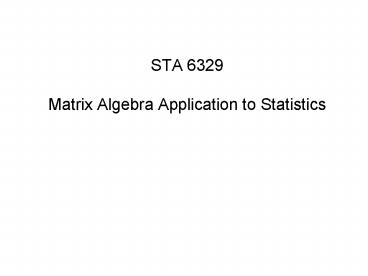STA 6329 Matrix Algebra Application to Statistics PowerPoint PPT Presentation
1 / 33
Title: STA 6329 Matrix Algebra Application to Statistics
1
STA 6329 Matrix Algebra Application to
Statistics
2
The life-expectancy webhttp//www.life-expectancy
.longtolive.com
- 1. Gender 2. date of birth
- 3. Stress level 4. smoking frequency
- 5. Alcohol consumption 6. Times brush your teeth
- 7. Time floss your teeth 8. Drink ___ oz coffee
- 9. Average hours of exercise/week 10. of meat
in diet - 11. How long your father lived? 12 How long your
mother lived? - 13. Your blood pressure SBP/DBP
Result Mark Yang will die on 09/09/2035 053334
am If
3
How do they know? From data
Suppose we have n death records with good
life-style information.
4
Data analysis and model building
Goal 1 How to solve ? in YX??? It turns out
that if ? is normally distributed, it is
equivalent to solve XX?XY.
5
A successful story genetic evaluation of farm
animals
Purpose Find the largest u (best individual with
milk production genes), because all the ? are
nonnegative. Ref Wiggans, ei al. Animal model
evaluation of Ayrshine milk yield with all
lactation, herd-sire interaction and groups based
on unknown parents, J. Dairy Sci., 771319-29
(1988). Data n119,541 cows, m5,762 sires, k
2 (constant, season).
6
There may be multiple responses.
- Example High school activities A, B, and C will
affect university grades of subjects D, E, F. - SAS type input
7
A simple way to describe a group of random
variables
8
From covariance to correlation
9
Early investigation in correlation Galtons
height inheritance
Francis Galton (1822-1911)
10
Positively correlated random variables
- From http//images.google.com/imgres?imgurlhttp/
/www.survo.fi/pictures/010e.gifimgrefurlhttp//w
ww.survo.fi/gallery/010.htmlh984w652sz21hl
enstart1sig2YqSEn4gSP_N_n0lPGm5hwwusg__-UEDX
lM4pr7Rw5IQr9WsRtxDRDUtbnidzhPI_739ZuXc9Mtbnh
149tbnw99eiaTW9SMmqMITmvQWky_jmAQprev/image
s3Fq3Dbivariate2Bnormal2Bdistribution26gbv3D
226hl3Den26safe3Dactive26sa3DG
11
Presidents and Heights
The Economist, April 27, 2002
12
The taller the better? Short women have more
children.
n 5,000 women born in Britain in March 1958
- The Economist, Aug. 17, 2002
13
Dimension Reduction
Goal 2 Given ?, how to find a matrix A s.t.
A?A is diagonal with as many 0 as possible in
the diagonal.
14
Real Data Microarray Analysis
- X-axis time (6 points) y-axis gene clustered
(yeast) - Data from DeRisi, JL, Iyer, VR, Brown, PO.
"Exploring the metabolic and genetic control of
gene expression on a genomic scale." Science.
1997 Oct 24278(5338)680-6.
15
DNA to mRNA to phenotype
16
From gene to protein
17
(No Transcript)
18
Idea Image
19
Application Breast classification
Science, Sept. 2000
20
Original dimension 6 time points
- Each dot represents a gene
21
Canonical Correlation
Goal 3 How do we solve the equation
?12?22-1?21-??110?
22
Real Data fMRI (functional magnetic resonance
imaging) on brain activities
Red color means High correlation.
- O. Friman, et al. Detection of neural activity
in functional MRI using Canonical Correlation
Analysis. Magnetic Resonance in Medicine Vol 45,
Number 2, Pages 323-330, 2001.
23
Findings
- fMRI response over 6 time points in 9 pixel
cluster (m54) - Stimulus pattern over time 6 frequency component
(n6). - To find Which pixel cluster is correlated with
the stimulus? - The top picture is by t-test, the middle is by
F-test and the bottom one is by canonical
correlation which has the most discovery.
24
Markov Chains
Goal 4 Give P, how to study the properties of
Pn?
25
(No Transcript)
26
Typical Mutation Analysis
27
General Markov Chains
28
Proofs
29
Real Data
- Nei, M. and Kumar, S. (2000) Molecular Evolution
and Phylogenetics. New York, NY Oxford
University Press.
30
Time Series Example
Again, Goal 4 Give P, how to study the
properties of Pn?
31
Kalman filter and GPS (Global Position System)
- http//en.wikipedia.org/wiki/Kalman_filter
- http//images.google.com/images?gbv2hlensafea
ctiveqsitewww.julien-cayzac.comkalmanfilter
andGPS
32
Basic Kalman filter equations to GPS
33
Summary What do we wish to know from matrix
algebra viewpoint (no statistics)?
Goal 1 How to solve ? in XX?XY? Goal 2
Given ?, how to find a matrix A s.t. A?A is
diagonal with as many 0 as possible in the
diagonal. Goal 3 How do we solve the equation
?12?22-1?21-??110? Goal 4 Give P, how to
study the properties of Pn? Numerical solution
is good, but analytical solution is better.

